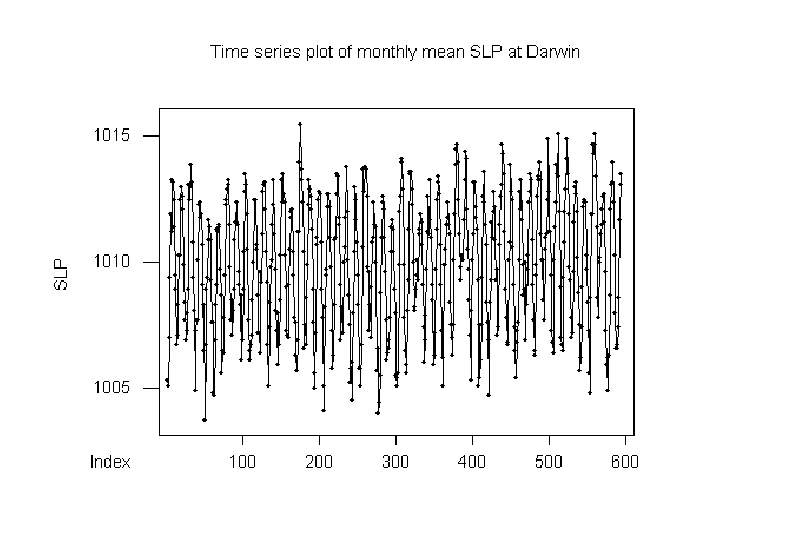



Next: Filtering and smoothing
Up: Introduction to time series
Previous: Introduction
Contents
A lot can be learnt about a time series by plotting  versus
versus
 in a time series plot. For example, the time series
plot in Figure 9.1 shows the evolution of monthly mean sea-level pressures
measured at Darwin in northern Australia.
in a time series plot. For example, the time series
plot in Figure 9.1 shows the evolution of monthly mean sea-level pressures
measured at Darwin in northern Australia.
Figure:
Time series of the montly mean sea-level pressure observed at Darwin
in northern Australia over the period January 1950 to July 2000.
 |
A rich variety of structures can be seen in the series that include:
- Trends - long-term changes in the mean level.
In other words, a smooth regular component consisting
primarily of Fourier modes having periods longer than the
length of the time series. Trends can be either deterministic
(e.g. world population) or stochastic. Stochastic
trends are not necessarily monotonic and can go up and down
(e.g. North Atlantic Oscillation). Extreme care should be
exercised in extrapolating trends and it is wise to always
refer to them in the past tense.
- (Quasi-)periodic signals - having clearly marked
cycles such as the seasonal component (annual cycle)
and interannual phenomena such as El Niño and business
cycles. For periodicities approaching the length of the
time series, it becomes extremely difficult to discriminate
these from stochastic trends.
- Irregular component - random or chaotic noisy
residuals left over after removing all trends and (quasi-)periodic
components.
They are (second-order) stationary if they have mean level
and variance that remain constant in time and can often be modelled
as filtered noise using time series models such as ARIMA.
Some time series are best represented as sums of these components
(additive) while others are best represented as products
of these components (multiplicative). Multiplicative series
can quite often be made additive by normalizing using
the logarithm transformation (e.g. commodity prices).




Next: Filtering and smoothing
Up: Introduction to time series
Previous: Introduction
Contents
David Stephenson
2005-09-30
![]() versus
versus
![]() in a time series plot. For example, the time series
plot in Figure 9.1 shows the evolution of monthly mean sea-level pressures
measured at Darwin in northern Australia.
in a time series plot. For example, the time series
plot in Figure 9.1 shows the evolution of monthly mean sea-level pressures
measured at Darwin in northern Australia.
